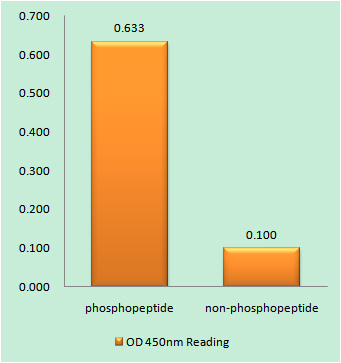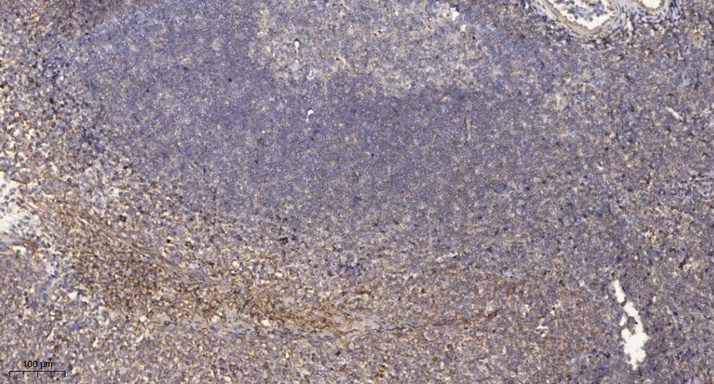PKD2 (phospho Ser876) Polyclonal Antibody
- Catalog No.:YP0341
- Applications:WB;IHC;IF;ELISA
- Reactivity:Human;Mouse;Rat
- Target:
- PKD2
- Fields:
- >>Rap1 signaling pathway;>>Aldosterone synthesis and secretion;>>Chemical carcinogenesis - reactive oxygen species
- Gene Name:
- PRKD2
- Protein Name:
- Serine/threonine-protein kinase D2
- Human Gene Id:
- 25865
- Human Swiss Prot No:
- Q9BZL6
- Mouse Gene Id:
- 101540
- Mouse Swiss Prot No:
- Q8BZ03
- Rat Gene Id:
- 292658
- Rat Swiss Prot No:
- Q5XIS9
- Immunogen:
- The antiserum was produced against synthesized peptide derived from human PKD2 around the phosphorylation site of Ser876. AA range:829-878
- Specificity:
- Phospho-PKD2 (S876) Polyclonal Antibody detects endogenous levels of PKD2 protein only when phosphorylated at S876.
- Formulation:
- Liquid in PBS containing 50% glycerol, 0.5% BSA and 0.02% sodium azide.
- Source:
- Polyclonal, Rabbit,IgG
- Dilution:
- WB 1:500 - 1:2000. IHC 1:100 - 1:300. ELISA: 1:40000.. IF 1:50-200
- Purification:
- The antibody was affinity-purified from rabbit antiserum by affinity-chromatography using epitope-specific immunogen.
- Concentration:
- 1 mg/ml
- Storage Stability:
- -15°C to -25°C/1 year(Do not lower than -25°C)
- Other Name:
- PRKD2;PKD2;HSPC187;Serine/threonine-protein kinase D2;nPKC-D2
- Observed Band(KD):
- 96kD
- Background:
- The protein encoded by this gene belongs to the protein kinase D (PKD) family of serine/threonine protein kinases. This kinase can be activated by phorbol esters as well as by gastrin via the cholecystokinin B receptor (CCKBR) in gastric cancer cells. It can bind to diacylglycerol (DAG) in the trans-Golgi network (TGN) and may regulate basolateral membrane protein exit from TGN. Alternative splicing results in multiple transcript variants encoding different isoforms. [provided by RefSeq, Jul 2008],
- Function:
- catalytic activity:ATP + a protein = ADP + a phosphoprotein.,enzyme regulation:Activated by diacylglycerol and phorbol esters.,function:Calcium-independent, phospholipid-dependent, serine- and threonine-specific protein kinase.,PTM:Autophosphorylated. Phorbol esters stimulates autophosphorylation. Phosphorylation of Ser-876 correlates with the activation status of the kinase.,similarity:Belongs to the protein kinase superfamily.,similarity:Belongs to the protein kinase superfamily. CAMK Ser/Thr protein kinase family. PKD subfamily.,similarity:Contains 1 PH domain.,similarity:Contains 1 protein kinase domain.,similarity:Contains 2 phorbol-ester/DAG-type zinc fingers.,tissue specificity:Widely expressed.,
- Subcellular Location:
- Cytoplasm . Cell membrane . Nucleus . Golgi apparatus, trans-Golgi network . Translocation to the cell membrane is required for kinase activation. Accumulates in the nucleus upon CK1-mediated phosphorylation after activation of G-protein-coupled receptors. Nuclear accumulation is regulated by blocking nuclear export of active PRKD2 rather than by increasing import. .
- Expression:
- Widely expressed.
- June 19-2018
- WESTERN IMMUNOBLOTTING PROTOCOL
- June 19-2018
- IMMUNOHISTOCHEMISTRY-PARAFFIN PROTOCOL
- June 19-2018
- IMMUNOFLUORESCENCE PROTOCOL
- September 08-2020
- FLOW-CYTOMEYRT-PROTOCOL
- May 20-2022
- Cell-Based ELISA│解您多样本WB检测之困扰
- July 13-2018
- CELL-BASED-ELISA-PROTOCOL-FOR-ACETYL-PROTEIN
- July 13-2018
- CELL-BASED-ELISA-PROTOCOL-FOR-PHOSPHO-PROTEIN
- July 13-2018
- Antibody-FAQs
- Products Images

- Western Blot analysis of various cells using Phospho-PKD2 (S876) Polyclonal Antibody diluted at 1:1000
.jpg)
- Western Blot analysis of HELA cells using Phospho-PKD2 (S876) Polyclonal Antibody diluted at 1:1000

- Enzyme-Linked Immunosorbent Assay (Phospho-ELISA) for Immunogen Phosphopeptide (Phospho-left) and Non-Phosphopeptide (Phospho-right), using PKD2 (Phospho-Ser876) Antibody

- Western blot analysis of lysates from NIH/3T3 cells treated with PMA 250ng/ml 15', using PKD2 (Phospho-Ser876) Antibody. The lane on the right is blocked with the phospho peptide.

- Immunohistochemical analysis of paraffin-embedded human tonsil. 1, Antibody was diluted at 1:200(4° overnight). 2, Tris-EDTA,pH9.0 was used for antigen retrieval. 3,Secondary antibody was diluted at 1:200(room temperature, 30min).

